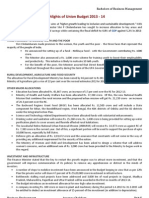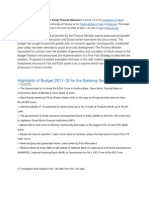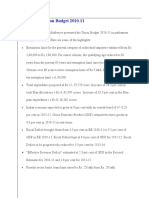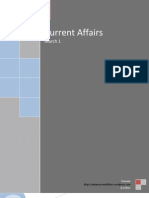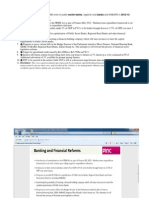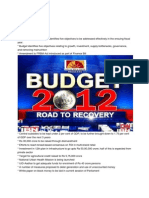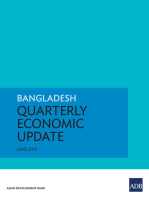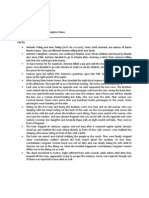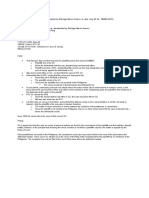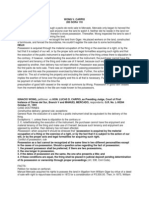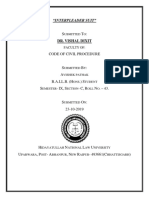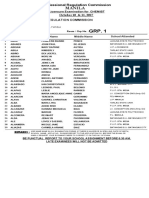Union Budget 2013 - 14 Highlights PDF Download: Some Basic Facts About Budget You SHOULD Know
Union Budget 2013 - 14 Highlights PDF Download: Some Basic Facts About Budget You SHOULD Know
Uploaded by
Rachna NagCopyright:
Available Formats
Union Budget 2013 - 14 Highlights PDF Download: Some Basic Facts About Budget You SHOULD Know
Union Budget 2013 - 14 Highlights PDF Download: Some Basic Facts About Budget You SHOULD Know
Uploaded by
Rachna NagOriginal Description:
Original Title
Copyright
Available Formats
Share this document
Did you find this document useful?
Is this content inappropriate?
Copyright:
Available Formats
Union Budget 2013 - 14 Highlights PDF Download: Some Basic Facts About Budget You SHOULD Know
Union Budget 2013 - 14 Highlights PDF Download: Some Basic Facts About Budget You SHOULD Know
Uploaded by
Rachna NagCopyright:
Available Formats
Union Budget 2013 -14 Highlights Pdf Download
Finance Minister of India Mr. P Chidambaram today (28th February 2013, Thursday) has presented the Union Budget for the financial year 2013-14. This is his 8th Union Budget. This budget is considered to be one of the most highly anticipated budgets of recent years, a blueprint for austerity that forms the centrepiece of India's efforts to stave off a damaging credit ratings downgrade.The Union Budget for 2013-14 aims at higher growth rate leading to inclusive and sustainable development as mool mantra. Some Basic Facts about Budget you SHOULD know Annual Financial Statement, usually termed as Budget, is a paper on proposed revenue and expenditure for the given financial year. Usually presented on the last working day of month of February, by the finance minister in LokSabha (not in Rajya Sabha).... Revenue side of budget include.... Tax n non Tax Revenues Tax revenues are procured from various direct and indirect taxes like corporate tax, income tax,customs duty, corporate tax etc... Non tax revenues include loans and advances from other countries etc. Expenditure side include plan n non plan expenditure.... Plan expenditure is expenditure for various segments and allocations there of like for agriculture, industry, mining,services etc... Non plan expenditure is expenditure for defense,subsidies, adm.expenses like salaries,pensions etc...
Here are some important highlights of the budget 2013 which are useful for upcoming competitive exams.
Finance Minister makes three promises: to women, youth and the poor. Nirbhaya Fund to empower women and to keep them safe and secure. Proposal to set up Indias first Womens Bank as a public sector bank. Rs. 1,000 crore for skill development of ten lakh youth to enhance their employability and productivity.
Direct Benefit Transfer (DBT) Scheme to be rolled out throughout the country during the term of UPA Government. Fiscal Deficit for 2013-14 is pegged at 4.8 percent of GDP. The Revenue Deficitwill be 3.3 percent for the same period. Plan Expenditure placed at Rs. 5,55,322 crore. It is 33.3 percent of the totalexpenditure while Non Plan Expenditure is estimated at Rs. 11,09,975 crore. Theplan expenditure in 2013-14 will be 29.4 percent more than the RE of the currentyear i.e. 2012-13. Substantial rise in allocation to the social sector. Allocation for RuralDevelopment Ministry raised by 46 percent to Rs. 80,194 crore. The target for farm credit for 2013-14 has been set at Rs. 7,00,000 crore against Rs. 5,75,000 crore during the current year. Rs. 10,000 crore earmarked for National Food Security towards the incremental cost. Education gets Rs. 65,867 crore, an increase of 17 percent over RE for 2012-13. ICDS gets Rs. 17,700 crore. This is 11.7 percent more than the current year. Drinking water and sanitation will receive Rs. 15,260 crore. Rs. 1,400 crore is being provided for setting up water purification plants to cover arsenic and fluoride affected rural areas. Health and Family Welfare Ministry has been allotted Rs. 37,330 crore. National Health Mission will get Rs. 21,239 crore which represents 24.3 percent over the RE. The Jawaharlal Nehru National Urban Renewal Mission (JNNURM) will receiveRs. 14,873 crore as against RE of Rs. 7,383 crore in the current year. Defence has been allocated Rs. 2,03,672 crore. Rs. 3,511 crore have been earmarked to Minority Affairs Ministry, 60 percent higher than RE for 2012-13. 2 The Government will encourage Infrastructure Debt Fund (IDF) and allow some institutions to raise tax free bonds upto Rs. 50,000 crore which is 100 percent more than the current year. India Infrastructure Finance Corporation (IIFC), in partnership with ADB willhelp infrastructure companies to access bond market to tap long term funds. Income limit under Rajiv Gandhi Equity Savings Scheme (RGESS) will be raised from Rs. 10 lakh to Rs. 12 lakh. First home loan from a bank or housing finance corporation upto Rs. 25 lakh entitled to additional deduction of interest upto Rs. 1 lakh. Proposal to launch Inflation Indexed Bonds or Inflation Indexed National Security Certificates to protect savings from inflation. On oil and gas exploration policy, the Budget proposes to move from the present profit sharing mechanism to revenue sharing. Natural gas pricing policy will be reviewed. On coal, the Budget proposes adoption of a policy of pooled pricing. Benefits or preferences enjoyed by MSME to continue upto three years after they grow out of this category. Refinancing capacity of SIDBI raised to Rs. 10,000 crore. Technology Upgradation Fund Scheme (TUFS) for textile to continue in 12th Plan with an investment target of Rs. 1,51,000 crore. Rs. 14,000 crore will be provided to public sector banks for capital infusion in 2013-14. A grant of Rs. 100 crore each has been made to 4 institutions of excellence including Aligarh Muslim University, Banaras Hindu University, Tata Institute of Social Sciences, Guwahati and Indian National Trust for Art and Cultural Heritage (INTACH). New taxes to yield Rs. 18,000 crore.
A surcharge of 10 percent on persons (other than companies) whose taxable income exceeds Rs.1 crore have been levied. Tobacco products, SUVs and Mobile Phones to cost more. Relief of Rs. 2000 for the tax payers in the first bracket of 2 to 5 lakhs. Voluntary Compliance Encouragement Scheme launched for recovering service tax dues. Rs. 9,000 crore earmarked as the first installment of balance of CST compensations to different States/UTs.
You might also like
- Treatise Superior Law Higher Law My LawDocument54 pagesTreatise Superior Law Higher Law My Law1 watchman100% (2)
- 07 2018 WP JOsCoS PDFDocument23 pages07 2018 WP JOsCoS PDFLoise EnglesNo ratings yet
- Local Government CodeDocument57 pagesLocal Government CodeJose Ruel Trobanos100% (1)
- Union BudgetUnion Budget 2013Document4 pagesUnion BudgetUnion Budget 2013Chiranjit DuttaNo ratings yet
- Budget Notes For SBI PO'sDocument3 pagesBudget Notes For SBI PO'svinnuganjiNo ratings yet
- Budget 2013-14 - Highlights - The Hindu PDFDocument4 pagesBudget 2013-14 - Highlights - The Hindu PDFPinak DebNo ratings yet
- Union Budgetmacro Economicsbudgets and Budgeting: TopicsDocument7 pagesUnion Budgetmacro Economicsbudgets and Budgeting: TopicsTarik HussainNo ratings yet
- Budget 2013 - 14Document3 pagesBudget 2013 - 14Jagdeep PabbaNo ratings yet
- Budget 2013Document15 pagesBudget 2013Sanjana BhattNo ratings yet
- Budget 2013-14: Highlights: Union Finance Minister P. Chidambaram Presents Budget 2013-14 in The Lok Sabha On ThursdayDocument11 pagesBudget 2013-14: Highlights: Union Finance Minister P. Chidambaram Presents Budget 2013-14 in The Lok Sabha On ThursdayAman RoyNo ratings yet
- Budget Highlights 2013-14Document18 pagesBudget Highlights 2013-14pallavichhikaraNo ratings yet
- O o o o o o o o o o o o o oDocument5 pagesO o o o o o o o o o o o o oAneesha KasimNo ratings yet
- General Budget 2013-14Document7 pagesGeneral Budget 2013-14Shibraiz AneesNo ratings yet
- Budget 2013 Summary MMS-B 88Document8 pagesBudget 2013 Summary MMS-B 88Manish KakaraNo ratings yet
- Budget 2013Document5 pagesBudget 2013@nshu_theachieverNo ratings yet
- Nion Udget: Prepared by Jignesh S Vamja - 4 SemDocument26 pagesNion Udget: Prepared by Jignesh S Vamja - 4 SemjigneshvamjaNo ratings yet
- India Union BudgetDocument12 pagesIndia Union BudgetMd DhaniyalNo ratings yet
- Budget Highlights 2013-14Document18 pagesBudget Highlights 2013-14Dhruva01No ratings yet
- Highlights of Budget 2011-12 For The Banking SectorDocument8 pagesHighlights of Budget 2011-12 For The Banking SectornehasachdevaNo ratings yet
- Budget 2013 PDFDocument6 pagesBudget 2013 PDFNitin NamdeoNo ratings yet
- Impact Analysis: Budget 2014-15Document4 pagesImpact Analysis: Budget 2014-15Raj AraNo ratings yet
- Expenditure Target of Rs 16,65,297 Crore in 2013-14. Plan Expenditure Is at Rs 5,55,320 Crore - Up 29 Per CentDocument8 pagesExpenditure Target of Rs 16,65,297 Crore in 2013-14. Plan Expenditure Is at Rs 5,55,320 Crore - Up 29 Per CentparamsnNo ratings yet
- Union Budget 2017-18 Key HighlightsDocument4 pagesUnion Budget 2017-18 Key HighlightsSushma KumariNo ratings yet
- Budget 2013Document15 pagesBudget 2013api-108000636No ratings yet
- February 2013 - Monthly PolicyDocument12 pagesFebruary 2013 - Monthly PolicyAbhishek Mani TripathiNo ratings yet
- Union BUDGET 2019-2020Document42 pagesUnion BUDGET 2019-2020fxfdsxshshsdhNo ratings yet
- Budget 2011-2012Document26 pagesBudget 2011-2012shaikameermalikNo ratings yet
- Union Budget 2024 Complete AnalysisDocument52 pagesUnion Budget 2024 Complete Analysisarushi4703No ratings yet
- Budget Highlights 2013: "Kalangathu Kanda Vinaikkan ThulangkathuDocument16 pagesBudget Highlights 2013: "Kalangathu Kanda Vinaikkan ThulangkathuSandeep SinghNo ratings yet
- Telecom Industry: Group Member: Sunil Soni Shashank Chaturvedi Mukesh Saurabh KumarDocument17 pagesTelecom Industry: Group Member: Sunil Soni Shashank Chaturvedi Mukesh Saurabh Kumarmukesh04No ratings yet
- Indian Budget 2011: Key Features of Finance Minister'S Budget 2011-2012 Overview of The EconomyDocument8 pagesIndian Budget 2011: Key Features of Finance Minister'S Budget 2011-2012 Overview of The EconomyVaibhav GuptaNo ratings yet
- Union Budget 2013-14: No Change in Income Tax Slabs Relief of Rs 2,000 For Tax Payers in Tax Bracket of Rs. 2-5 LakhDocument1 pageUnion Budget 2013-14: No Change in Income Tax Slabs Relief of Rs 2,000 For Tax Payers in Tax Bracket of Rs. 2-5 LakhShruti SharmaNo ratings yet
- BSC Feb GA RefresherDocument32 pagesBSC Feb GA RefreshervishnusankarNo ratings yet
- Union Budget 2013-14: Key Takeout's From The BudgetDocument4 pagesUnion Budget 2013-14: Key Takeout's From The BudgetFeedback Business Consulting Services Pvt. Ltd.No ratings yet
- Highlights of Union Budget 2010-11Document4 pagesHighlights of Union Budget 2010-11jain_priyanka05No ratings yet
- Union Union Budget 2015-2016 February 28, 2015: WWW - Careerpower.inDocument8 pagesUnion Union Budget 2015-2016 February 28, 2015: WWW - Careerpower.inManish MishraNo ratings yet
- Current Affairs March 1Document19 pagesCurrent Affairs March 1Puneet_TryLoNo ratings yet
- Edristi February 2019 English PDFDocument148 pagesEdristi February 2019 English PDFmadhukar tiwariNo ratings yet
- Food Bill Eco Survery. Union Budget RailbudgetDocument4 pagesFood Bill Eco Survery. Union Budget RailbudgetDisha AroraNo ratings yet
- 24.07.2024 - The Banking FrontlineDocument11 pages24.07.2024 - The Banking Frontlinesomu10789No ratings yet
- 1732626682Document10 pages1732626682introonly7No ratings yet
- Union Budget 2012Document11 pagesUnion Budget 2012vivek1245No ratings yet
- February 28, 2015: Key Features of Budget 2015-2016Document17 pagesFebruary 28, 2015: Key Features of Budget 2015-2016Rajendra Prasad R SNo ratings yet
- BudgetDocument18 pagesBudgetsandeeplkccommerceNo ratings yet
- Budget & Economy SurveyDocument21 pagesBudget & Economy Surveykogec75384No ratings yet
- General Budget 2010Document7 pagesGeneral Budget 2010avnehguddanNo ratings yet
- Union Budget 2023-24: Why in News?Document11 pagesUnion Budget 2023-24: Why in News?Adil Khan PathanNo ratings yet
- The Highlights of The Union Budget 2013-14 Are As FollowsDocument2 pagesThe Highlights of The Union Budget 2013-14 Are As FollowsarchenigmaNo ratings yet
- A Project On Analysis of Budget 2009-2010Document19 pagesA Project On Analysis of Budget 2009-2010Mohan KumarNo ratings yet
- Eco Project FinalDocument7 pagesEco Project FinalVirag ShingaviNo ratings yet
- Infusion of Rs.15888 Crore in Public, Regional Rural and NABARD inDocument12 pagesInfusion of Rs.15888 Crore in Public, Regional Rural and NABARD inFASNAASLAMNo ratings yet
- Key Features of Indian Union Budget-2014Document21 pagesKey Features of Indian Union Budget-2014mbalajimeNo ratings yet
- BudgetDocument18 pagesBudgetsandeeplkccommerceNo ratings yet
- Union Budget 2018 HighlightsDocument6 pagesUnion Budget 2018 Highlightstamanna13No ratings yet
- Union Budget 2018 HighlightsDocument6 pagesUnion Budget 2018 Highlightstamanna13No ratings yet
- Comparative Analysis of 2015Document3 pagesComparative Analysis of 2015Swathy AjayNo ratings yet
- Presentation1 CBR BudgetDocument18 pagesPresentation1 CBR Budgetsunnykumar.m2325No ratings yet
- Inshare Share On TumblrDocument7 pagesInshare Share On TumblrSyamily ChandranNo ratings yet
- Budget 2014-15 Analysis - Vedantam GuptaDocument3 pagesBudget 2014-15 Analysis - Vedantam GuptaVedantam GuptaNo ratings yet
- Key Features of Budget 2014-2015: The Current Economic Situation and The ChallengesDocument21 pagesKey Features of Budget 2014-2015: The Current Economic Situation and The ChallengesBakrudeen Ali AhamedNo ratings yet
- Asia’s Fiscal Challenge: Financing the Social Protection Agenda of the Sustainable Development GoalsFrom EverandAsia’s Fiscal Challenge: Financing the Social Protection Agenda of the Sustainable Development GoalsNo ratings yet
- Shawarma HouseDocument7 pagesShawarma HouseSyed AliNo ratings yet
- Land LawDocument20 pagesLand LawS M Tayzul Islam67% (3)
- Criminal Procedure (Midterms) : - Rule 110, Sec. 1 ROCDocument31 pagesCriminal Procedure (Midterms) : - Rule 110, Sec. 1 ROCFrancis GuinooNo ratings yet
- CPCS Implementing Circular No.2016-01 (Re-Eissued)Document4 pagesCPCS Implementing Circular No.2016-01 (Re-Eissued)lejigeNo ratings yet
- People V TolingDocument3 pagesPeople V TolingKitty Reyes100% (4)
- Barangay San Nicolas 2 Betis: Office of The Brgy. CouncilDocument3 pagesBarangay San Nicolas 2 Betis: Office of The Brgy. Councilsan nicolas 2nd betis guagua pampangaNo ratings yet
- Criminal Petition No.4664 of 2020Document4 pagesCriminal Petition No.4664 of 2020skmanjunathagmNo ratings yet
- Chaos in The Courtroom Reconsidered Emotional Bias and Juror NullificationDocument20 pagesChaos in The Courtroom Reconsidered Emotional Bias and Juror NullificationJen ShawNo ratings yet
- Reso 5 - 2023 Commending SK Dakila 18-23Document3 pagesReso 5 - 2023 Commending SK Dakila 18-23sangguniangkabataan96No ratings yet
- Labor Relations Reviewer Morillo PDFDocument35 pagesLabor Relations Reviewer Morillo PDFLance MorilloNo ratings yet
- DTI Initial Complaint FormDocument1 pageDTI Initial Complaint FormRodolfo Lastimoso Diaz Jr.No ratings yet
- Laude CaseDocument13 pagesLaude CaseRen ConchaNo ratings yet
- Ang Rep by Marvin Aceron Vs Spouses AngDocument1 pageAng Rep by Marvin Aceron Vs Spouses AngGillian Caye Geniza BrionesNo ratings yet
- Introduction and The PleadingsDocument8 pagesIntroduction and The PleadingsFREDRICK WAREGANo ratings yet
- Important Articles of Indian ConstitutionDocument15 pagesImportant Articles of Indian Constitutionabhiswami000000No ratings yet
- Int'l Med. Devices. v. Cornell - ComplaintDocument266 pagesInt'l Med. Devices. v. Cornell - ComplaintSarah BursteinNo ratings yet
- Property Possession CasesDocument29 pagesProperty Possession CasesMark Joseph ReyesNo ratings yet
- Ncnda of IccDocument4 pagesNcnda of IccEric WongNo ratings yet
- Bench Bulletin Issue 60Document80 pagesBench Bulletin Issue 60MaryNo ratings yet
- Examen Inglés de Galicia (Extraordinaria de 2018)Document2 pagesExamen Inglés de Galicia (Extraordinaria de 2018)Helen DenizNo ratings yet
- de Leon Vs Del RosarioDocument3 pagesde Leon Vs Del RosarioLeo TumNo ratings yet
- Aglibot vs. SantiaDocument1 pageAglibot vs. SantiaAnonymous 5MiN6I78I0No ratings yet
- Avishek CPC ProjectDocument21 pagesAvishek CPC ProjectAvishek PathakNo ratings yet
- Guidelines For Law Firms or Government Offices Supervising Apprentices From Silliman University - College of LawDocument3 pagesGuidelines For Law Firms or Government Offices Supervising Apprentices From Silliman University - College of LawBrylle Deeiah TumarongNo ratings yet
- JHCBC 2021 433404Document1 pageJHCBC 2021 433404samsdanish07No ratings yet
- Official PN FormDocument1 pageOfficial PN Formmelvin terrazolaNo ratings yet
- RA CHEMIST MLA Oct2017 PDFDocument38 pagesRA CHEMIST MLA Oct2017 PDFPhilBoardResultsNo ratings yet







